By Jael Batty
Water quality can be evaluated quickly, efficiently, and cost-effectively through the use of bioindicators. The presence and activities of microorganisms can indicate changes in system operations and point to the source and magnitude of an issue.1
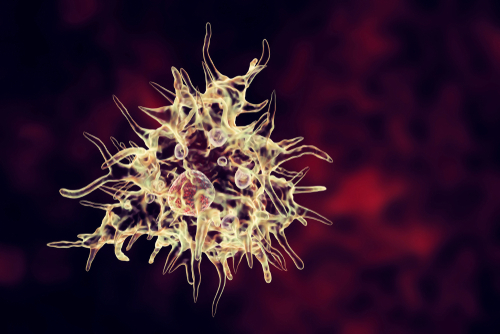
amoebae
Protozoa
Approximately 4% of the microorganisms in wastewater are protozoa, which are single-celled aerobic microorganisms. Protozoa improve effluent clarity by digesting suspended particles and bacteria. Protozoa are sensitive to temperature, pH, dissolved oxygen, and nutrient availability. The presence of certain protozoa are indicators of treatment system performance. Nutrient deficiencies or low dissolved oxygen content will limit the number and type of protozoa.2

flagellates
Amoebae, which are present early in the process, die off as food decreases. Because they feed on solid particles in the water, large numbers of amoebae present in the aeration basin discharge are an indicator of a shock load of BOD, large amounts of particulates, and/or low oxygen.2
Like amoebae, flagellates are present during start-up. They feed on soluble organic matter and dispersed bacteria. Flagellates are more efficient feeders than amoebae and will quickly dominate. However, flagellates decline when bacteria begin reproducing, out-competing them for nutrients. Flagellates are the first microorganisms to reappear after an upset. Flagellates also appear in lagoons that have low dissolved oxygen content and high soluble BOD. Because they feed on dead microorganisms, a bloom of flagellates is a good indicator of toxicity, high loading, pond turnover, or an increase in BOD.3

ciliates
Ciliates remove suspended and free-dispersed bacteria. Free-swimming ciliates begin to appear as flagellates begin to disappear. They die back as floc particles increase and dispersed bacteria decreases, at which time crawling/grazing ciliates flourish. Crawling ciliates dominate in a well-balanced activated sludge process. They graze on floc particles and feed on bacteria at the edges of floc. Stalked/sessile ciliates are present at the end process. They may grow singly or in colonies. As sludge matures, colonial stalked ciliates dominate single-stalked ciliates. If the sludge matures too long, nutrients and bacteria become unavailable and protozoa-eating protozoa, such as the suctoria, dominate.4
Metazoa
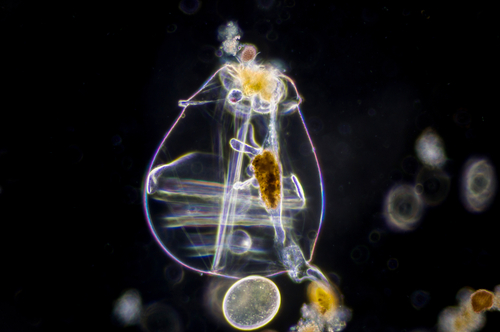
rotifer
Only 1% of the microorganisms in wastewater treatment are metazoa, which are multi-cellular aerobic microorganisms. Generally found in lagoons, metazoa feed on bacteria, algae, and protozoa. Metazoa are affected by toxins. Like protozoa, the presence and activity of specific metazoa indicates the treatment system environment.4,5
Rotifers, which aid effluent clarification, produce a sticky secretion that helps keep floc clumped together. They are usually the first affected by toxins.
Tardigrades (water bear), which feed on algae and small protozoa, are also sensitive to toxins but can survive environmental extremes. The presence of tardigrades indicates long sludge age, low F/M ratios, good BOD degradation, and low ammonia levels.4,5
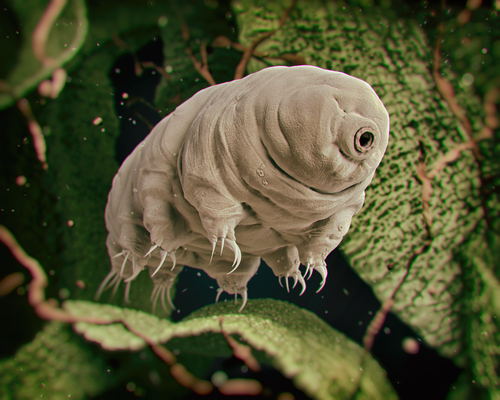
tardigrade
Nematodes, which feed on bacteria, protozoa, fungus, and other nematodes, can be found in high numbers in older sludges and trickling filters. They tunnel through floc, slime, and biofilm, increasing oxygen penetration, preventing excess build up, and keeping it porous. Their presence, growth, and movement are bioindicators of long sludge age, changes in wastewater conditions. They are sensitive to anoxic conditions, and their population decreases in warm temperatures.4,5
Like water bears, aquatic flatworms can survive humidity and temperature extremes, but they are sensitive to low dissolved oxygen levels as well as toxins. The presence of tubiflex, or sludge worms, is an indication of pollution.4,5
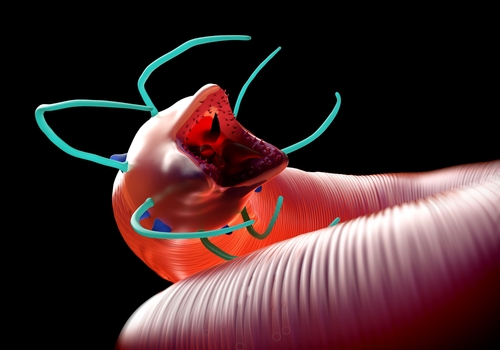
nematode
Cladocera, or water fleas (Daphnia), which are related to shrimp, are present in clean lagoon effluent. They consume algae and bacteria. They can control issues with TSS caused by excessive algae, but not without affecting the dissolved oxygen content. In oxygen-deficient environments, they turn pink or red as they produce hemoglobin. Schools of water fleas may leave red streaks in a lagoon, which indicates low dissolved oxygen. Water fleas are highly sensitive to toxicity and ammonia.6,7
Copepods are crustaceans found in clean lagoon effluent that is free of toxins. Copepods are opportunistic feeders that eat small organic particles that drift toward them. They thrive in a stable wastewater environment with high dissolved oxygen and low bacteria.8
Bacteria

Daphnia
Bacteria account for 95% of the microorganisms in wastewater. They are single-celled microorganisms, classified based on their response to oxygen. Aerobic bacteria use dissolved oxygen to break down wastewater contaminants, converting it into energy. Anaerobic bacteria derive their oxygen from nutrients. As anaerobic bacteria break down sludge, they produce methane gas. Facultative bacteria can switch between aerobic and anaerobic forms, depending on the oxygen content of their environment.1,2
Bacteria are dispersed, reproducing, growing, and actively seeking out food when nutrient levels are high. As nutrient levels drop, bacteria slow down and develop a slime layer on their cell walls. This slime layer causes bacteria to clump or floc, forming masses that settle and separate from wastewater liquids.9
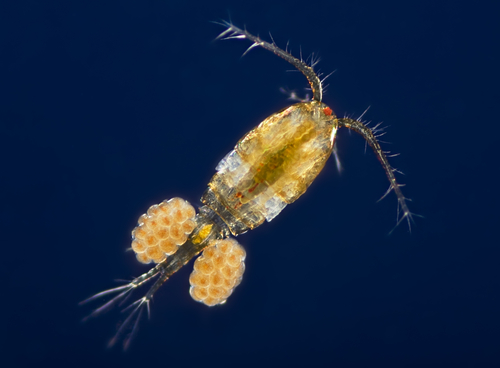
copepod
When nutrient levels remain high, the bacteria remain dispersed and do not form floc. Nutrient levels that are too low interfere with the development of the cell wall, which results in floc dispersion, sludge bulking, slime bulking, and foaming.9
Filamentous bacteria grow in long hair-like strands, connecting together to form a web that is important in floc formation. Filamentous bacteria are an indicator of changes in pH, temperature, available nutrients, FOGs, sludge load, and dissolved oxygen. Excessive growth of filamentous bacteria can interfere with settling, causing bulking and foaming. Filamentous bulking may occur upon recovery from a toxic load as filamentous bacteria recover faster than floc-forming bacteria.10
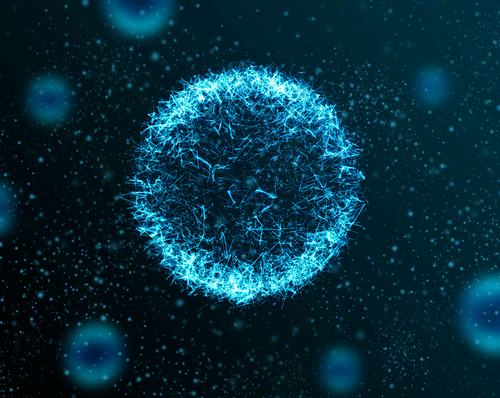
bacteria
Read more about bacteria in last week’s blog post.
Algae and Fungi
Algae and fungi indicate sludge age, as well as issues with pollution or pH. Algae are indicative of excess nutrients and may be present during warmer, sunnier temperatures, and following an upset. While algae can be used to lower BOD, in high numbers it can cause elevated TSS at the effluent. Fungi may develop with high BOD levels. Untreated fungi can cause issues with settling and dewatering.4
Bioremediation
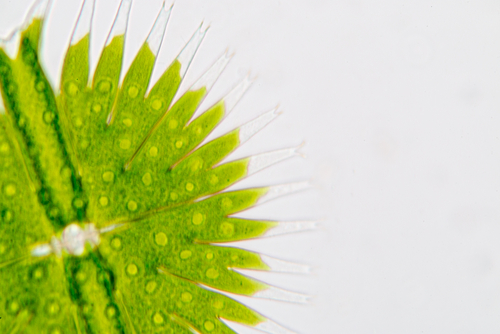
algae
Bioremediation is a process of treating wastewater to encourage the growth of existing microorganisms in specific groups or as a whole. With biostimulation, supplemental nutrients, vitamins, minerals, organic acids, and pH buffers are introduced into wastewater to create a hospitable environment that stimulates naturally occurring microorganisms. Bioaugmentation, the addition of microorganisms, may be used to restart activated sludge systems or to aid in the breakdown of a targeted pollutant.
Bioremediation increases the bio-oxidation of wastewater and reduces grease, sludge, and odor levels in wastewater treatment plants, lagoons, and ponds. Bioremediation is used to degrade heavy metals, petroleum compounds, and hazardous wastes. Biostimulant and bioaugmentation products help reduce wastewater toxicity, sludge handling costs, and power use.11
Conclusion
The presence, absence, excessive occurrence, and activities of microorganisms signify wastewater condition throughout the stages of treatment. A careful observation of bioindicators is a cost-effective and efficient way to control wastewater operations and the quality of wastewater so that bioremediations can be made as necessary.1
- J Németh-Katona (2008). The Environmental Significance of Bioindicators in Sewage Treatment,
https://www.uni-obuda.hu/journal/Nemethne-Katona_15.pdf - P Madoni (2009). Protozoa in wastewater treatment processes: A minireview, Italian Journal of Zoology
https://www.tandfonline.com/doi/full/10.1080/11250000903373797 - E Rumbaugh (2014). What do Flagellate Protozoa Mean in my Wastewater Treatment Plant? Biological Waste Treatment Expert, https://www.biologicalwasteexpert.com/blog/what-do-flagellate-protozoa-mean-in-my-wastewater-treatment-plant
- T Glymph (2005). Wastewater Microbiology: A Handbook for Operators, https://www.iowaruralwater.org/tools_tips/toni_glymp/Bacteria-Protozoa.pdf
- (2019). Nematodes and flatworms, Climate Policy Watcher,
https://www.climate-policy-watcher.org/wastewater-treatment-3/nematodes-and-flatworms-worms.html - P Hill (2017). Why Are There Red Streaks in My Lagoon? About Lagoon Daphnia, Triplepoint Water Technologies, https://www.triplepointwater.com/lagoon-daphnia/
- M Meyer (2018). Web exclusive: What water fleas say about your lagoon water quality, Water & Wastes Digest,
https://www.wwdmag.com/wastewater-treatment/web-exclusive-what-water-fleas-say-about-your-lagoon-water-quality - J Dürbaum, TD Künnemann (2010). Biology of Copepods,
https://web.archive.org/web/20100525103620/https://www.uni-oldenburg.de/zoomorphology/Biology.html - R Fuller (2017). Food-to-Mass (F:M) Ratio, The Wastewater Blog,
https://www.thewastewaterblog.com/single-post/2016/12/19/Food-to-Mass-Ratio - G. Shamoon (2014), Filamentous Bacteria in Wastewater Treatment, Mold & Bacteria Consulting Laboratories,
- LM Coelho, HC Rezende, LM Coelho, PAR de Sousa, DFO Melo, and NMM Coelho (2015). Bioremediation of Polluted Waters Using Microorganisms, https://www.intechopen.com/books/advances-in-bioremediation-of-wastewater-and-polluted-soil/bioremediation-of-polluted-waters-using-microorganism
Related Posts

BHN’s Lyndon Smith Meets with Senator James E. Risch (R-ID)
BHN President/CEO Lyndon Smith (far left) meets with Idaho Senator James E. Risch (third from left) and others at the Agricultural Retailers Association (ARA) Winter Board Meeting in Washington, D.C. BHN’s leonardite mine is located in Idaho.

Live Aid: Music That Fed the World (and Filled My Parents’ Basement)
This Week In Ag #124: Live Aid: Music That Fed the World (and Filled My Parents’ Basement) This past Sunday marked the 40th anniversary of the greatest PR and musical event in history. It was held at Wembley Stadium in London. And at JFK Stadium in Philadelphia. It was viewed by nearly 40% of the world’s population. The event was Live Aid, a benefit concert to raise money and awareness for famine relief in Africa. It was the event that forged a generation, my generation, Gen X. I’ll never forget that day. Dad was among the first in our neighborhood to purchase a satellite dish. I threw a party that day, attended by seemingly every college-aged aggie in the county (or at least dad seemed to think so)

This Week in Ag #19
Rain makes grain. Those words are as old as farming itself. In the nation’s breadbasket – the three I states, which produce 42% of our corn and 37% of our soybeans – there’s concern over the lack of rain. That triggered a major movement in the grain market. Drought officially grips 100% of the I

